Thermistor Sensor Blog Archive
The thermistor sensor blog archive contains articles relating to temperature measurement, compensation, and control.
- Temperature Sensing Issues: Troubleshooting, Tips and Solutions
- NTC Thermistor vs. RTDs: Choosing the Right Sensor
- Thermistors and Flyback Diodes: Motor Protection in Action
- Dielectric Strength in Electrical Systems
- ThermiVolt NTC Probe: Temperature Sensor and Voltage Monitor
- Electric Vehicles: Thermistors and Battery Management Systems
- Sensor Selection: The Advantages of NTC Temperature Sensors
- Ametherm’s Guide To Kinked Leads
- PTC Inrush Current Limiters: Advantages and Disadvantages
- Temperature Probes: Protecting Premature Babies
- Temperature Sensors – Thermistors versus Thermocouples
- Thermistor Temperature Sensor Plays a Role in Bowling
- When to Use NTC Thermistor Probes and Why It’s Necessary
- 4 Most Common Types of Temperature Sensor
- Designing a Furnace Fan and Limit Controller Using an NTC Thermistor and an Arduino Microcontroller
- Using Epoxy to Protect NTC Thermistors
- ACCU-Curve Series Thermistor With Insulated Tinned-Copper Leads
- Ametherm’s Temperature Sensor and Inrush Current Limiter Part Numbers Decoded
- NTC Thermistor Temperature Sensors Provide Li-Ion Battery Safety
- Arduino and Thermistors – The Secret to Accurate Room Temperature
- Thermistor Fan Control in Gaming Applications
- 5 Thermistor Sensor Considerations When Selecting An NTC Thermistor
- Glass-Encapsulated Thermistors For Automotive and Industrial Applications
- Thermal Time Constant and NTC Thermistors: A Practical Study
- Thermistor – Temperature Detection Fire Alarm Example
- The Secret To Successful Thermistor Beta Calculations
- NTC Thermistors Used In Tesla Hyperloop Pod
- Thermistors used to Measure Temperature in Lake Tahoe
- ACCU-CURVE™ Thermistors for High Accuracy Temperature Sensing
- Temperature Sensor for Control and Compensation Circuits
- How to Select the Optimal Temperature Sensor
- Temperature Sensor for Control and Compensation Circuits
- ACCU-CURVE™ Series of Interchangeable Thermistors
- NTC Disc Thermistors Available at Rhopoint

Temperature Sensing Issues: Troubleshooting, Tips and Solutions
Temperature sensing is a critical aspect of various industries and applications, from electronics and automotive to healthcare and food safety. Reliable temperature measurements are essential for maintaining product quality, safety, and performance. However, like any technology, temperature sensors, including thermistors, can encounter issues that affect their accuracy and reliability. In this blog post, we will explore common temperature sensing issues and provide valuable tips and solutions for troubleshooting them. Inaccurate … Continue Reading

NTC Thermistor vs. RTDs: Choosing the Right Sensor
Temperature measurement is a crucial aspect of many industries, from manufacturing and electronics to healthcare and automotive. When it comes to selecting the right temperature sensor, two popular options are NTC thermistors (Negative Temperature Coefficient thermistors) and RTDs (Resistance Temperature Detectors). In this blog post, we’ll explore what NTC thermistors and RTDs are, discuss their strengths and weaknesses, and help you make an informed decision based on your specific application … Continue Reading

Thermistors and Flyback Diodes: Motor Protection in Action
In the world of motors, sparks can fly, sometimes quite literally! When you turn off a motor, the sudden drop in current can create a voltage spike. This surge can harm sensitive electronic components like transistors and controllers. That’s where thermistors and flyback diodes come into play, working together to protect your motor. Thermistors: Temperature-Sensitive Protectors Picture the motor as a coil packed with energy. When you suddenly stop it … Continue Reading

Dielectric Strength in Electrical Systems
Electricity powers our daily lives, and behind the scenes, there’s a crucial factor ensuring the safety and reliability of electrical systems—dielectric strength. In this blog post, we’ll explore the practical importance of dielectric strength, its applications in various domains, and its role in thermistors. Understanding Dielectric Strength: Essential in Electrical Resilience Dielectric strength measures a material’s ability to endure electric stress without breaking down. When an electric field is applied, … Continue Reading
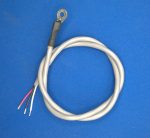
ThermiVolt NTC Probe: Temperature Sensor and Voltage Monitor
Revolutionizing Temperature Sensing and Voltage Monitoring In the fast-paced world of technology, where precision and reliability are paramount, our new ThermiVolt NTC Probe with temperature sensing and voltage monitoring stands out as a pioneer in dual-function sensing. These innovative probes seamlessly integrate temperature sensing and voltage monitoring, providing unparalleled accuracy and safety for a myriad of applications. How ThermiVolt NTC Probes Work: A Fusion of Expertise Temperature Sensing with Precision … Continue Reading

Electric Vehicles: Thermistors and Battery Management Systems
As the automotive industry rapidly shifts towards sustainability and environmental consciousness, electric vehicles (EVs) emerge as the forefront of this transformation. They promise reduced emissions and enhanced energy efficiency, redefining transportation. While battery technology and electric motors often steal the spotlight, the thermistor plays a vital role in the EV ecosystem. Let’s delve into the importance of thermistors in electric vehicles and understand why they are poised to remain indispensable … Continue Reading
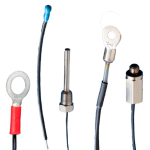
Sensor Selection: The Advantages of NTC Temperature Sensors
In our interconnected world, sensors have become vital tools that drive technology and innovation. They act as the eyes and ears of countless devices, enhancing our convenience and efficiency. NTC (Negative Temperature Coefficient) temperature sensors, in particular, excel at accurately measuring temperature. In this blog post, we will explore sensors, how they operate, and why NTC’s are an excellent choice for various applications. Understanding Sensors Sensors are instruments that detect … Continue Reading

Ametherm’s Guide To Kinked Leads
Ametherm is a trusted name in the field of inrush current limiting thermistors, providing solutions for a wide range of applications. To help you choose the right inrush thermistor for your specific needs, Ametherm offers three different lead types. These leads are crucial for proper installation and can significantly impact the effectiveness of the thermistor in your circuit. No Kink, Straight Leads: No Dash When you come across an Ametherm … Continue Reading
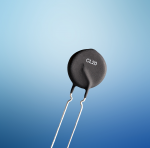
PTC Inrush Current Limiters: Advantages and Disadvantages
PTC’s Are Solutions to Inrush Current Inrush current, also known as startup or surge current, occurs when an electrical device is switched on, and it can exceed the device’s typical operating current significantly. This abrupt surge can strain the components of the circuit and can result in premature failure. Positive Temperature Coefficient devices have emerged as effective solutions for controlling inrush current in various applications. In this article, we will … Continue Reading

Temperature Probes: Protecting Premature Babies
Ametherm’s Sensing Thermistors have a seemingly unlimited number of applications. But when it comes to caring for premature babies in incubators, temperature probes take on an even more critical role in ensuring the health and well-being of these fragile infants. Read about the 4 Most Common Temperature Sensors Gentle Temperature Sensing With their ability to sense temperature changes with precision, these sensors also provide a gentle and non-invasive way to … Continue Reading

Temperature Sensors – Thermistors versus Thermocouples
Thermistors vs. Thermocouples Temperature sensors are important for everyday life, from working in industrial plants to preventing fires. Thermistors and thermocouples are two such temperature sensors. A thermistor is a thermally sensitive resistor that exhibits a continuous, small, incremental change in resistance correlated to temperature variations. Thermocouples reflect proportional changes in temperature through the varying voltage created between two dissimilar metals electrically bonded together. Both are good options for temperature … Continue Reading
Thermistor Temperature Sensor Plays a Role in Bowling
Thermistor temperature sensors have broad applicability NTC Thermistors are non-linear resistors that alter their resistance with temperature. Resistance on an NTC probe will decrease predictably as the temperature increases allowing for extremely accurate temperature measurements. These temperature sensors have applications within environmental science, prevention, medical, building automation, aerospace, automotive, life safety, and others. One industry not immediately thought of for thermistor temperature sensors is the bowling industry. A … Continue Reading
When to Use NTC Thermistor Probes and Why It’s Necessary
NTC Thermistor Probes Have Endless Applications NTC thermistor probes measure liquid levels and temperature in industries that extend from automotive electronics to medical technology to green energy. Their applications are endless, and their purpose ensures the operability of the applications they serve. A thermistor probe, can also be as simple as an NTC thermistor chip, encapsulated with epoxy or glass. Or, it can be potted in a metal or plastic housing … Continue Reading
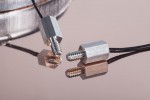
4 Most Common Types of Temperature Sensor
Temperature sensors range in accuracy and responsiveness Some applications, such as equipment used to create life-saving medications, require temperature sensors to be responsive and accurate for critical quality control; however, some applications, like the thermometer in your car, don’t require as accurate or responsive sensors. The four most common types of temperature sensors, ranging in responsiveness and accuracy from high to low are: Negative Temperature Coefficient (NTC) Thermistors Resistance Temperature … Continue Reading

Designing a Furnace Fan and Limit Controller Using an NTC Thermistor and an Arduino Microcontroller
Written By Joe Conti NTC thermistors are a great way to control the power functions of a residential furnace system. These thermistors can sense the air temperature in the furnace heating chamber and turn the power on and off. Replacing the power control of the furnace with a temperature sensor is easy to do. This article will walk you through how to do this starting with an Arduino microcontroller and … Continue Reading
Using Epoxy to Protect NTC Thermistors
One common way to protect NTC thermistors from damage that might impair performance is to encase them or house them in epoxy. The chemical characteristics used to protect NTC thermistors are found in industrial grade epoxy with a high dielectric strength and thermal conductivity. An epoxy coated NTC thermistor temperature sensor appears as a tear-drop-shaped bead with two radial wire leads. Very often these types of NTC thermistor temperature sensors … Continue Reading

ACCU-Curve Series Thermistor With Insulated Tinned-Copper Leads
Interchangeable Device Eliminates Conduction Between Leads for the Highest Temperature Sensing Accuracy Ametherm today (April 9 2018) announced that the company has extended the capabilities of its ACCU-Curve series of interchangeable NTC thermistors with the ACL-011. This new device features insulated tinned-copper leads, ensuring the most accurate temperature sensing with no unintended conduction between leads. Ametherm’s ACL-011 delivers long-term stability and reliability for high-accuracy temperature sensing, control, and compensation in … Continue Reading

Ametherm’s Temperature Sensor and Inrush Current Limiter Part Numbers Decoded
From the creation of the first inrush current limiter series, back in 1994, Ametherm knew that having logic behind the series naming convention would be important. Not only for organizational means but also to easily identify the components of the inrush current limiters and NTC thermistor temperature sensors. Both product lines, the inrush current limiters and NTC thermistor temperature sensors, have stringent guidelines created to get the most accurate description … Continue Reading

NTC Thermistor Temperature Sensors Provide Li-Ion Battery Safety
NTC thermistor temperature sensors are a key component in Li-Ion battery charging and safety. They provide critical temperature data required to keep the Li-Ion battery in the optimum condition during the charging cycle. Careful management of temperature during charging prolongs battery life and avoids hazards inherent to Li-Ion batteries. Li-Ion Batteries Power Green Energy Due to their light weight and high energy density, Li-Ion batteries are used exclusively in consumer electronics. Li-Ion batteries are … Continue Reading

Arduino and Thermistors – The Secret to Accurate Room Temperature
We’ve made a discovery and wanted to share it with you; introducing the Arduino Uno. If you’re an electronics geek who’s been wanting to learn more about the vast community of “Hardware Hackers” out there, read on! We discovered that you could hack together some awesome stuff with an Arduino Uno and other electrical components such as thermistor temperature sensors. And when you combine the Arduino and thermistors the possibilities are endless. We … Continue Reading

Thermistor Fan Control in Gaming Applications
NTC Thermistors For Cooling Applications Thermistors are expanding in their applications every day. This year, EVGA, an American computer hardware company, redesigned its leading cooler to better monitor and cool power components in addition to the Graphics Processing Unit (GPU) component. In order to accomplish this, EVGA introduced Negative Temperature Coefficient (NTC) thermistors to its Printed Circuit Board (PCB). These NTC thermistors express large decreases in resistance in response to … Continue Reading

5 Thermistor Sensor Considerations When Selecting An NTC Thermistor
These 5 thermistor sensor considerations will make selecting the right NTC thermistor easy Selecting a thermistor temperature sensor can be confusing, and you have a lot of options to choose from. You don’t want to risk equipment failure or circuit breaker short-outs. So, how do you make the right selection without sacrificing performance and giving up quality? See what the 5 thermistor sensor considerations are all about to find out! … Continue Reading
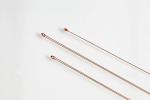
Glass-Encapsulated Thermistors For Automotive and Industrial Applications
Application Overview Ametherm’s DG series glass-encapsulated thermistors provide long-term stability and reliability for high-accuracy temperature sensing in automotive and industrial applications. Hermetically sealed, the thermistors eliminate errors in resistance readings due to moisture penetration, while offering high operating temperatures and a compact size. Provides faster, more accurate, and less expensive alternatives to thermocouples and RTD probes Free from limitations due to solder temperature, which enables them to offer users a … Continue Reading

Thermal Time Constant and NTC Thermistors: A Practical Study
The Relationship between Thermal Time Constant and Temperature Sensors In this article, we’ll break down the relationship between the thermal time constant and NTC thermistors. We’ll also cover the importance of selecting the right thermistor with characteristics that will produce the correct thermal time constant for your application. Further down in this article, we demonstrate one way to measure thermal time constant; running two tests, then present the results. What is Thermal … Continue Reading

Thermistor – Temperature Detection Fire Alarm Example
Thermistors serve a crucial role in temperature detection. For example, thermistor temperature detection can be used in fire alarms to detect fires based on a sudden change in temperature. Unlike photoelectric detectors or ionization alarms, thermistors only require heat to activate. Thermistors are temperature-sensing elements made of semiconductor material that displays large changes in resistance in proportion to small changes in temperature. Photoelectric and Ionization Fire Alarms The photoelectric detector requires heavy smoke … Continue Reading

The Secret To Successful Thermistor Beta Calculations
What Do RT1, RT2, T1, and T2 Have In Common? They are the main components of Thermistor Beta Calculations as it relates to temperature measurement, compensation, and control. And if you are an engineer in an industry such as automotive or HVAC where things like coolant and air intake temperatures are crucial to the safety and performance of a vehicle or unit, chances are you will deal with beta calculations … Continue Reading

NTC Thermistors Used In Tesla Hyperloop Pod
Award-Winning Hyperloop Pod Uses NTC Thermistors A team of engineers use NTC thermistors in their design for a high-speed transportation pod. The thermistors accurately sense temperatures and create a map of the application’s heat. Teslarati recently conducted an interview with members of the Badgerloop team, 3rd-place winners of SpaceX’s Hyperloop Pod design competition in January. The Hyperloop is Tesla CEO Elon Musk’s “fifth mode” of transportation where passengers in a … Continue Reading

Thermistors used to Measure Temperature in Lake Tahoe
Recently, the SFGate released an article about how thermistors are used to measure temperature change in Lake Tahoe. The article states that over the past 40 years, global warming has caused the temperature of lakes to rise, affecting the natural habitat for fish species and algae blooms. Scientists at the Tahoe Environmental Research Center carefully monitor the lake’s temperature using thermistors carried by large ocean buoys. Signals from the buoys transmit data via satellite to scientists at NASA’s Jet Propulsion Laboratory in … Continue Reading
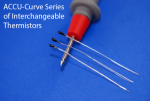
ACCU-CURVE™ Thermistors for High Accuracy Temperature Sensing
What’s an ACCU-CURVE™ Thermistor? ACCU-CURVE™ thermistors are used for high-accuracy temperature sensing, control, and compensation in medical, industrial, and automotive applications. They also deliver long-term stability and reliability, while offering interchangeability over a broad temperature range. This eliminates the need to individually calibrate or provide circuit compensation for part variability. Accurate temperature measurement to ±0.2°C is available over the 0°C to 70°C temperature range. Standard ohmic values at 25°C range from 2,252 to 100,000 ohms. ACCU-CURVE™ Thermistor vs. … Continue Reading
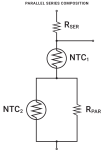
Temperature Sensor for Control and Compensation Circuits
To use a temperature sensor in a control or compensation circuit, the detection circuit must provide an output in a usable format. For analog circuits, the output is usually a resistance. For digital control and compensation, the measurement needs to be converted to a digital format for processing by an MCU. This is commonly achieved by reading the measurement as a voltage using an analog to digital converter (ADC). Semiconductor-based sensors … Continue Reading

How to Select the Optimal Temperature Sensor
When designing a temperature detection circuit, it is important that you don’t pay for more than what is actually needed. By understanding the requirements of an application, an optimal temperature sensor can be selected that minimizes cost without compromising performance, accuracy, or reliability. There are several factors to consider when selecting a sensor. They are outlined in the table below. Temperature Sensor Selections NTC Thermistor Platinum RTD Thermocouple Semiconductor … Continue Reading
Temperature Sensor for Control and Compensation Circuits
To use a temperature sensor in a control or compensation circuit, the detection circuit must provide an output in a usable format. For analog circuits, the output is usually a resistance. For digital control and compensation, the measurement needs to be converted to a digital format for processing by an MCU. This is commonly achieved by reading the measurement as a voltage using an analog to digital converter (ADC). Semiconductor-based sensors … Continue Reading

ACCU-CURVE™ Series of Interchangeable Thermistors
We are excited to announce that we are now offering ACCU-CURVE™ series thermistors. These are a new series of interchangeable thermistors used for temperature sensing, control, and compensation. They are best suited for applications that require a high degree of measurement accuracy over a wide temperature range. Common applications include medical, industrial, and automotive. Read the full press release here. Why choose the ACCU-CURVE™ series? The ACCU-CURVE™ series offers faster … Continue Reading

NTC Disc Thermistors Available at Rhopoint
We have exciting news! U.K.- based Rhopoint Components now carries our series of NTC disc thermistors acquired from Measurement Specialties (formerly RTI electronics). These components deliver high stability and maximum sensitivity for temperature measurement, compensation, and control. You can read the full press release here. NTC Disc Thermistor Applications NTC disc thermistors offer extreme precision and temperature measurement for various applications. They are used in a wide range of industries including aerospace, military, appliance, medical, and automotive. … Continue Reading



